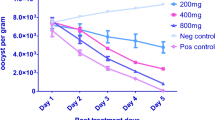Abstract
The study was designed to evaluate the anticoccidial activity of the methanolic extract of Musa paradisiaca root in chickens. The chickens were divided into six groups of 12 chickens each. Each chicken in five groups was infected with 8,000 infective coccidia (Eimeria tenella) oocysts at day 28 of age while one group served as uninfected control. At day 7 post-infection, two chickens remaining in each group were sacrificed for postmortem examination to confirm coccidiosis. Also at day 7 post-infection, each chicken in four infected groups was given graded doses (250, 500 and 1,000 mg/kg b.w.) of the extract or amprolium (conventional drug). Two groups (an infected and uninfected group) did not receive treatment. Parameters used to assess progress of infection and response to treatment included clinical signs typical of coccidiosis, oocyst count per gramme of faeces (OPG) and packed cell volume (PCV). Treatment of previously infected chickens with M. paradisiaca root extract resulted in a progressive decrease in severity of observed clinical signs, marked reductions in OPG and a gradual increase in PCV. In each case, the changes were dose dependent. There was no significant difference in mean OPG and mean PCV of the extract (at 1,000 mg/kg b.w.) and amprolium-treated groups at termination of the study (at day 50 of age). In the acute toxicity study, the extract was found to be non-toxic to the chickens even at the highest dose of 4,000 mg/kg b.w. The results of this study demonstrated that the extract has anticoccidial activity in a dose-dependent manner and at a dosage of 1,000 mg/kg b.w. had similar efficacy with amprolium in the treatment of chicken coccidiosis.
Similar content being viewed by others
References
Calo, M., Altavilla, D., Seminara, P., Marini, H., Minutoli, L., Bitto, A., Naccan, F. and Squadrito, F., 2005. Inhibition of lipid peroxidation by IRFI 042, a vitamin E analogue, decreases monensin cardiotoxicity in chicks, Toxicity and Applied Pharmacology, 208, 137–144.
Campbell, T.W. and Coles, E.H., 1986. Avian clinical pathology. In: E.H. Coles (eds), Veterinary clinical pathology, 4th edition, (Saunders, Philadelphia), 279–300.
Fajimi, A.K and Taiwo, A.A., 2005. Herbal remedies in animal parasitic diseases in Nigeria: a review, African Journal of Biotechnology, 4(4), 303–307.
Fanatico, A., 2006. Parasite management for natural and organic poultry. Coccidiosis. National Sustainable Agriculture Information Service. www.attra.ncat.org, Retrieved 28th Dec. 2009
Guo, F.C., Suo, X., Zhang, G.Z. and Shen, A.G., 2007. Efficacy of decoquinate against drug sensitive laboratory strains of Eimeria tenella and field isolates of Eimeria spp. in broiler chickens in China, Veterinary Parasitology, 147, 239–245.
Jang, S.I., Jun, M., Lillehoj, H.S., Dalloul, R.I., Kong, I., Kim, S. and Min, W., 2007. Anticoccidial effect of green tea-based diets against Eimeria maxima, Veterinary Parasitology, 144, 172–175.
Lee, S.H., Lillehoj, H.S., Park, D.W., Jang, S.I., Morales, A., Garcia, D., Lucio, E., Larios, R., Victoria, G., Marrufo, D. and Lillehoj, E.P., 2009. Protective effect of hyperimmune egg yolk IGY antibodies against Eimeria maxima infections, Veterinary Parasitology, 163, 123–126.
McDougald, L.R. and Reid, W.M., 1997. Coccidiosis. In: B.W. Calnek (eds), Diseases of Poultry, 10th Ed., (Iowa State University Press, Ames), 865–883.
Michelle, R., 1994. Transaction of the Illinois State Academy of Science, 87: 51–59.
Naidoo, V., McGaw, L.J., Bisschop, S.P.R., Duncan, N. and Eloff, J.N., 2008. The value of plant extracts with antioxidant activity in attenuating coccidiosis in broiler chickens, Veterinary Parasitology, 154, 214–219.
National Research Council (NRC), 1985. Guide for the Care and Use of Laboratory Animals, (US Department of Health and Human Services, Washington).
Nweze, N.E. and Obiwulu, I.S., 2009. Anticoccidial effects of Ageratum conyzoides, Journal of Ethnopharmacology, 122, 6–9.
Ogbe, A.O., Mgbojikwe, L.O., Abdu, P.A. and Atawodi, S.E., 2008. Organ and carcass weight variation and histopathological changes in Eimeria tenella infected broiler chickens treated with aqueous extract of a wild mushroom (Ganoderma lucidum), Electronic Journal of Environmental, Agricultural and Food Chemistry, 7(5), 2906–2913.
Ojewole, J. and Adewumi, C., 2003. Hypoglycemic effect of methanolic extract of Musa paradisiaca green fruit in normal and diabetic mice, Journal of Experimental and Clinical Pharmacology, 25(6), 453–458.
Oladoja, M. A. and Olusanya, T.P., 2007. Adoption of coccidiosis vaccines by poultry farmers in Ijebu area of Ogun State, Nigeria, International Journal of Poultry Science, 6(12), 883–887.
Singh, T. and Gupta, R.P., 2003. Clinico-haematological and mineral studies on experimental maduramycin toxicity in chickens, Veterinary Parasitology, 116(4), 345–353.
Tafara, M., John, F.M. and Emily, F.K., 2005. The efficacy of banana plant as a coccidiostat in rabbits, International Journal of Applied Research in Veterinary Medicine, 3(4), 326–330.
Vassilev, D.G., 2002. Special modification of Mc Master. In: B. Cumming (ed), Manual of veterinary parasitological techniques. (Central Veterinary Laboratory, London).
Conflict of interests
There are no conflicts of interests related to this work.
Author information
Authors and Affiliations
Corresponding author
Rights and permissions
About this article
Cite this article
Anosa, G.N., Okoro, O.J. Anticoccidial activity of the methanolic extract of Musa paradisiaca root in chickens. Trop Anim Health Prod 43, 245–248 (2011). https://doi.org/10.1007/s11250-010-9684-1
Accepted:
Published:
Issue Date:
DOI: https://doi.org/10.1007/s11250-010-9684-1




